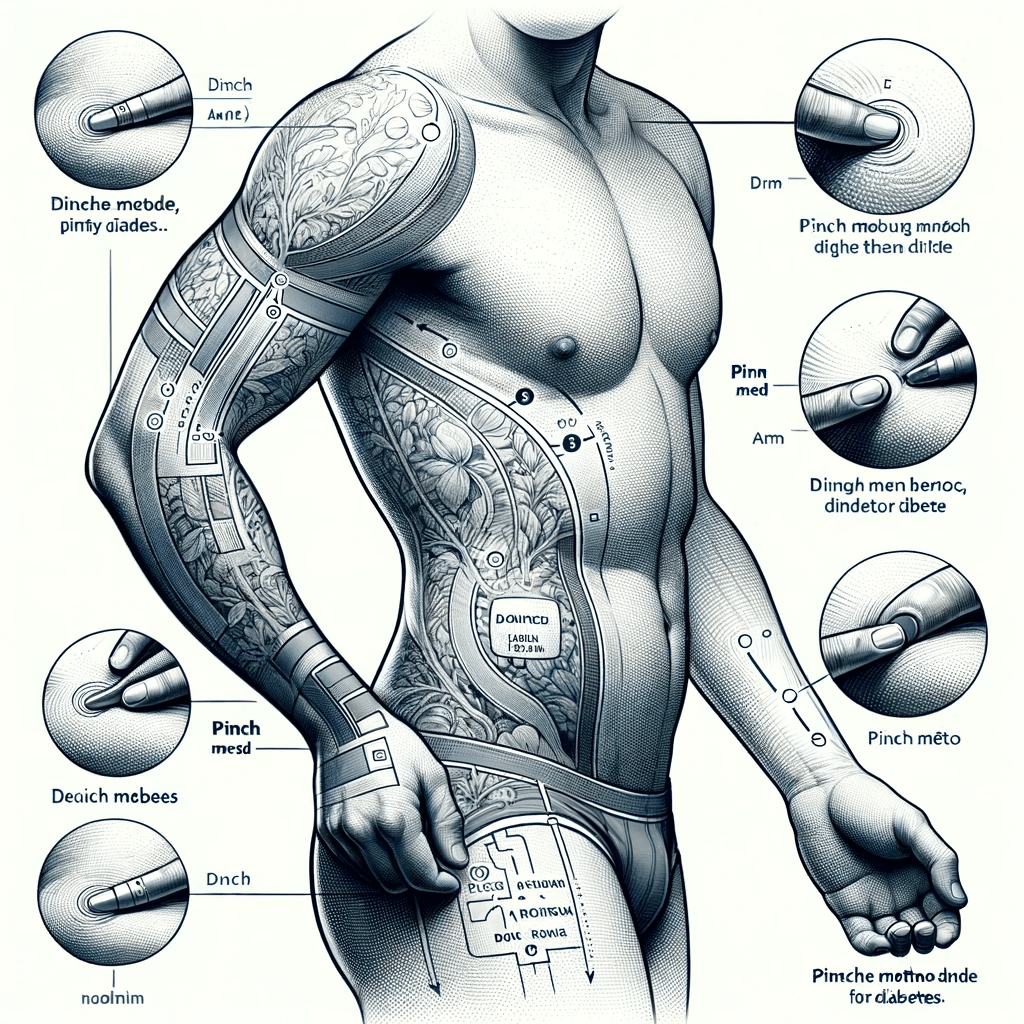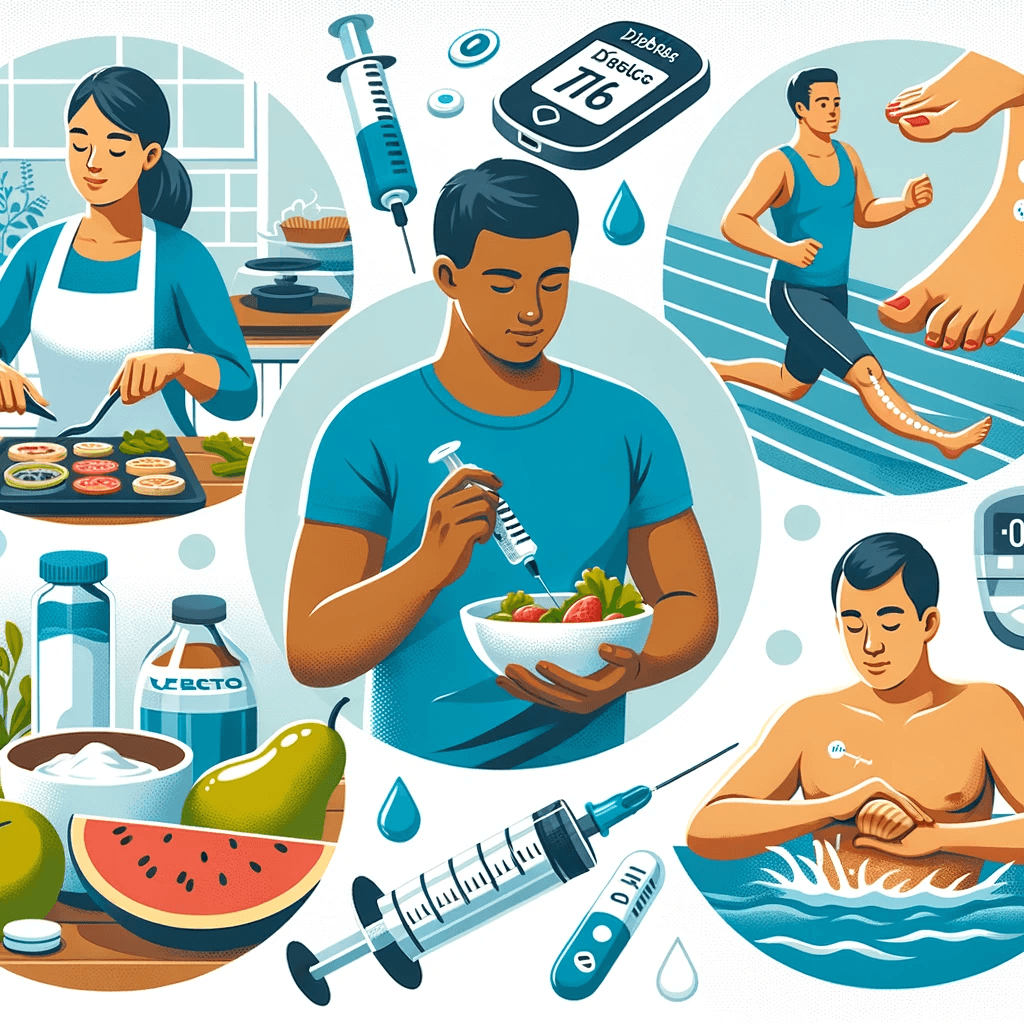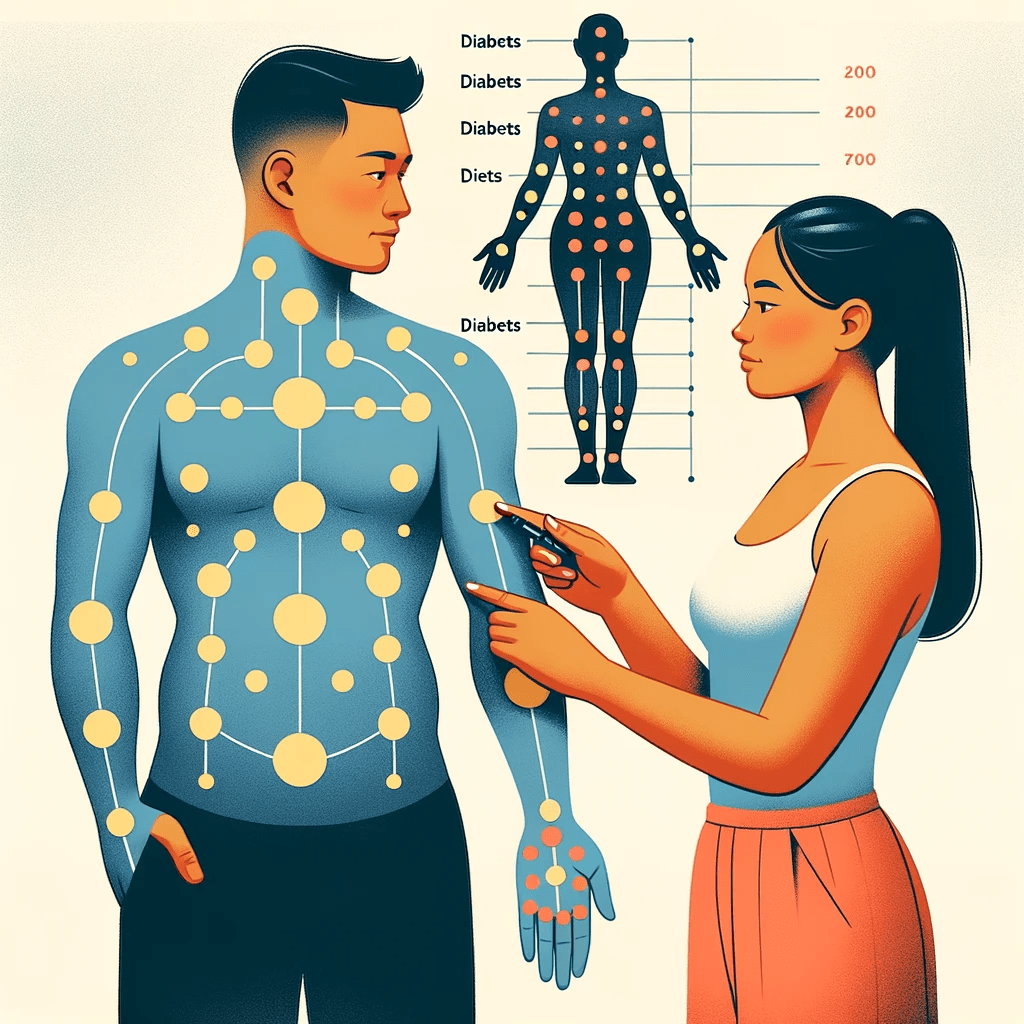The pinch method is a popular technique used for managing blood sugar levels in individuals with diabetes. It involves gently pinching specific areas of the body to stimulate blood flow and reduce insulin resistance. While there is limited scientific evidence supporting its effectiveness, some individuals find it helpful in self-managing their condition. In addition to exploring the pinch method, this article, Show Me How to Do the Pinch Method for Diabetes, will also discuss other self-management techniques, the role of acupressure, traditional methods of diabetes control, and medications commonly prescribed for type 2 diabetes. Seeking professional advice is always recommended when considering alternative methods.
- What is the pinch method for diabetes
- Understanding the Pinch Method for Diabetes - Show Me How to Do the Pinch Method for Diabetes
- How to Perform the Pinch Method: Step-by-Step Guide - Show Me How to Do the Pinch Method for Diabetes
- The Benefits of the Pinch Method for Managing Blood Sugar Levels - Show Me How to Do the Pinch Method for Diabetes
- Exploring Other Self-Managing Techniques for Diabetes - Show Me How to Do the Pinch Method for Diabetes
- The Role of Acupressure in Diabetes Management - Show Me How to Do the Pinch Method for Diabetes
- Incorporating Traditional Diabetes Control Methods - Show Me How to Do the Pinch Method for Diabetes
- Medications and Treatments for Type 2 Diabetes
- Seeking Professional Advice: Consultation with a Healthcare Provider
- Precautions and Considerations for Self-Management Methods
- What is the pinch method for diabetes
- What is the pinch method for diabetes
What is the pinch method for diabetes
The Pinch Method for diabetes is a term that has been circulating around the internet, often associated with non-medical advice promising an easy fix or cure for diabetes. It is crucial to clarify that this method is not recognized by the medical community nor supported by scientific evidence. Diabetes management typically involves lifestyle changes, medication, and monitoring of blood sugar levels. Any method claiming to 'reverse' diabetes through simple techniques should be approached with skepticism and discussed with a healthcare professional. The following list outlines some key components of legitimate diabetes management:
- Healthy Eating: Consuming a balanced diet that is low in processed sugars and rich in nutrients.
- Regular Exercise: Engaging in consistent physical activity to help manage blood sugar levels.
- Medication: Taking prescribed medications, including insulin or oral drugs, as directed by a healthcare provider.
- Blood Sugar Monitoring: Regularly checking blood sugar levels to ensure they remain within a target range.
- Education: Learning about diabetes and understanding how to manage it effectively.
- Stress Management: Reducing stress through various techniques, which can positively affect blood sugar levels.
Understanding the Pinch Method for Diabetes - Show Me How to Do the Pinch Method for Diabetes
The pinch method is a technique that has been used for managing blood sugar levels in individuals with diabetes. It involves gently pinching specific areas of the body to stimulate blood flow and improve insulin sensitivity. Although its effectiveness is not scientifically proven, some people have found it beneficial as a complementary approach to diabetes management.
The pinch method is believed to work by stimulating certain points on the body, potentially increasing blood circulation and reducing insulin resistance. However, it is important to note that relying solely on this method may delay more effective actions for controlling high blood sugar levels.
While the pinch method itself doesn't cause harm, it is crucial to prioritize traditional methods of diabetes control, such as maintaining a healthy diet, reducing sugar intake, and engaging in regular exercise. In addition, medications like insulin, metformin, and other oral medications may be prescribed based on individual needs.
It's important to remember that exploring alternative methods like the pinch method can be considered, but seeking medical advice from healthcare professionals is essential for effective management of type 2 diabetes. Always consult with a healthcare provider before adopting any new method or treatment. Additionally, incorporating Western medicine guidelines, such as a balanced diet, regular exercise, and prescribed medications, is essential for proper blood sugar control and prevention of diabetes complications.
How to Perform the Pinch Method: Step-by-Step Guide - Show Me How to Do the Pinch Method for Diabetes
Performing the pinch method for managing blood sugar levels in diabetes involves a simple, yet precise technique. Follow these step-by-step instructions to effectively perform the pinch method:
- Start by washing your hands thoroughly with soap and warm water to maintain proper hygiene.
- Choose a specific pinch point on your body, such as the fleshy part of your forearm or the fatty area of your abdomen.
- Gently pinch the chosen area between your thumb and index finger. Apply enough pressure to feel a slight pinch sensation without causing discomfort or pain.
- Hold the pinch for about 10 to 15 seconds and then release the pressure.
- Repeat the process on different pinch points, maintaining a consistent rhythm.
- Perform the pinch method several times a day, ideally before meals or when you experience high blood sugar levels.
It's important to note that the pinch method complements traditional diabetes management techniques and should not replace medical advice or prescribed treatments. Always consult with your healthcare provider before incorporating any self-management methods into your diabetes care routine.
The Benefits of the Pinch Method for Managing Blood Sugar Levels - Show Me How to Do the Pinch Method for Diabetes
The pinch method, a technique used to manage blood sugar levels in diabetes patients, offers several potential benefits:
- Improved Blood Flow: The gentle pinching of specific areas stimulates blood circulation, enhancing the delivery of oxygen and nutrients to cells.
- Reduced Insulin Resistance: By pinching certain points on the body, the pinch method may help decrease insulin resistance, allowing cells to better utilize glucose.
- Easy to Perform: This method is straightforward and can be performed by individuals with diabetes in the comfort of their own homes.
- Complementary Technique: The pinch method can be used alongside traditional diabetes management strategies, such as diet and exercise, to further support blood sugar control.
- No Known Harmful Effects: When performed correctly, the pinch method poses minimal risks or side effects.
It is important to note that the pinch method should not replace conventional treatments or professional medical advice. While some individuals may find it helpful, its effectiveness may vary, and it should be used as part of a comprehensive diabetes management plan.
Consultation with a healthcare provider is crucial to ensure that the pinch method is appropriately integrated into an individual's overall diabetes care. They can provide personalized guidance and monitor the effectiveness of this technique.
Exploring Other Self-Managing Techniques for Diabetes - Show Me How to Do the Pinch Method for Diabetes
Aside from the pinch method, there are various self-managing techniques that can help individuals with diabetes effectively control their blood sugar levels. These techniques focus on lifestyle modifications and alternative therapies that can complement traditional diabetes management strategies. Here are some self-management options to consider:
- Dietary Modifications: Following a healthy, well-balanced diet is crucial for diabetes management. Consuming foods rich in fiber, whole grains, lean proteins, and healthy fats can promote stable blood sugar levels.
- Regular Physical Activity: Engaging in regular exercise helps improve insulin sensitivity and aids in maintaining a healthy weight. Aim for at least 150 minutes of moderate-intensity aerobic activity per week.
- Stress Management: Chronic stress can negatively impact blood sugar control. Exploring stress-reducing techniques such as mindfulness meditation, yoga, or engaging in hobbies can be beneficial.
- Monitor Blood Sugar Levels: Regularly checking blood sugar levels helps individuals understand how their bodies react to certain foods and activities. This information enables better decision-making in diabetes management.
- Weight Management: Maintaining a healthy weight plays a vital role in diabetes control. Losing excess weight through a combination of healthy eating and physical activity can improve insulin sensitivity.
Remember, self-managing techniques should be used in conjunction with medical advice and treatment plans tailored to individual needs. Incorporating these strategies into your daily routine can contribute to better blood sugar control and overall well-being.
The Role of Acupressure in Diabetes Management - Show Me How to Do the Pinch Method for Diabetes
Acupressure is an ancient technique that has been used for thousands of years in traditional Chinese medicine. It involves applying pressure to specific points on the body to stimulate healing and promote overall well-being. In the context of diabetes management, acupressure has shown promise in helping to regulate blood sugar levels and improve insulin sensitivity.
By targeting acupressure points such as ST-36 and SP-6, individuals with diabetes may experience enhanced insulin production and glucose uptake. People believe that these specific points connect to the pancreas and digestive system, directly impacting insulin levels and blood sugar control.
Note that you should practice acupressure under the supervision of a qualified healthcare provider or experienced complementary medicine practitioner. They can guide you in properly locating the acupressure points and applying the right amount of pressure.
While acupressure may offer potential benefits for diabetes management, it should not replace conventional medical treatments. People best use it alongside diet, exercise, and any prescribed medications or insulin therapy as a complementary approach. Consult with your healthcare provider to determine if acupressure is suitable for you and to ensure it aligns with your overall diabetes management plan.
Remember, acupressure is just one tool in managing diabetes, and its effectiveness may vary from person to person. It's always essential to work closely with your healthcare team to develop a comprehensive approach to managing your diabetes.
Incorporating Traditional Diabetes Control Methods - Show Me How to Do the Pinch Method for Diabetes
Alongside alternative approaches like the pinch method, traditional diabetes control methods play a crucial role in managing blood sugar levels effectively. By incorporating these time-tested techniques into your routine, you can enhance your overall diabetes management and reduce the risk of complications.
- Healthy Diet: A balanced and nutritious diet is fundamental for diabetes control. Focus on consuming whole foods, including fruits, vegetables, lean proteins, and whole grains. Limit your intake of sugary and processed foods.
- Regular Exercise: Engaging in physical activity is vital for managing diabetes. Aim for at least 150 minutes of moderate aerobic exercise per week, such as brisk walking, swimming, or cycling. Additionally, incorporate strength training exercises into your routine, focusing on major muscle groups.
- Weight Management: Maintaining a healthy weight is important for diabetes control. If overweight, losing even a small amount of weight can improve insulin sensitivity and help manage blood sugar levels more effectively.
- Monitoring Blood Sugar: Regularly checking your blood sugar levels using a glucose meter and keeping a record can provide valuable insights into your diabetes management. It enables you to adjust your diet, exercise, and medication regimen as needed.
- Medication Management: If prescribed medication for diabetes management, it is crucial to take it as directed by your healthcare provider. Adhering to the prescribed dosage and schedule is essential for optimal results.
By incorporating these traditional diabetes control methods into your daily routine, you can complement alternative approaches like the pinch method and achieve better blood sugar control, reducing the risk of complications associated with diabetes.
Medications and Treatments for Type 2 Diabetes
In addition to self-management techniques, there are various medications and treatments available for effectively managing type 2 diabetes. Healthcare professionals design these interventions to control blood sugar levels and reduce complication risks.
1. Insulin: Insulin is a hormone that helps regulate blood sugar levels. Healthcare professionals may prescribe it for individuals struggling to produce or utilize insulin effectively. There are different types of insulin available, including rapid-acting, short-acting, intermediate-acting, and long-acting insulin.
2. Metformin: Metformin is an oral medication that helps lower blood sugar levels by reducing glucose production in the liver and improving insulin sensitivity. Healthcare professionals often recommend it as a first-line treatment for type 2 diabetes.
3. Other Oral Medications: Healthcare professionals may prescribe several oral medications to manage blood sugar levels in type 2 diabetes. These include sulfonylureas, meglitinides, thiazolidinediones, DPP-4 inhibitors, SGLT2 inhibitors, and GLP-1 receptor agonists. Each medication works differently to help lower blood sugar levels.
4. Combination Therapy: In some cases, healthcare professionals may prescribe a combination of medications for optimal blood sugar control. This may involve combining different types of oral medications or using a combination of oral medications with insulin.
5. Lifestyle Modifications: Along with medications, lifestyle modifications play a crucial role in managing type 2 diabetes. This includes adopting a healthy diet that is low in sugar and saturated fats, engaging in regular physical activity, maintaining a healthy weight, and managing stress levels.
It is important to consult with a healthcare provider to determine the most suitable medications and treatments for individual needs. Regular monitoring of blood sugar levels and adherence to the prescribed treatment plan are key to effectively managing type 2 diabetes.
Seeking Professional Advice: Consultation with a Healthcare Provider
When it comes to managing your diabetes and exploring various self-management techniques, seeking professional advice from a healthcare provider is crucial. They have the necessary knowledge and expertise to guide you in making informed decisions regarding your diabetes management.
During a consultation, your healthcare provider will evaluate your specific needs, medical history, and current health status. They will discuss the pinch method and alternative self-management techniques, helping you determine the most appropriate approach for your condition.
Discussing your goals and concerns with a healthcare provider can provide valuable insights and personalized recommendations. They can advise on incorporating the pinch method into your diabetes plan, assessing its benefits and limitations.
Healthcare providers recommend diet, exercise, and stress management for traditional diabetes control. They may also prescribe medication or other treatments tailored to your individual needs.
Remember, collaboration with a healthcare provider is essential in achieving optimal diabetes management. They can monitor your progress, address any complications, and adjust your treatment plan as necessary. Regular follow-ups and communication with healthcare providers are key to managing type 2 diabetes effectively.
Precautions and Considerations for Self-Management Methods
Consider precautions and factors for safety and effectiveness when exploring diabetes self-management methods. Here are some key points to keep in mind:
- Consult a healthcare provider: Before starting any self-management technique, it is crucial to consult with a healthcare provider. They can provide personalized advice, assess your specific condition, and guide you on the appropriate methods for your situation.
- Combine with traditional methods: Self-management methods can be beneficial, but they should not replace traditional diabetes control techniques. Use them with lifestyle changes like a healthy diet, regular exercise, and prescribed medications.
- Be aware of potential risks: Self-management techniques like the pinch method may not be suitable for everyone. Those with certain conditions should consult a healthcare provider before trying new diabetes-related methods.
- Monitor blood sugar levels: Regularly monitor blood sugar to ensure effective self-management and maintain optimal control. Tracking your blood sugar levels can also provide valuable insights into the effectiveness of different techniques.
Remember, always approach diabetes self-management methods with caution and seek guidance from a healthcare professional. Combine methods, monitor blood sugar, seek professional advice to manage diabetes effectively and improve health.
What is the pinch method for diabetes
The Pinch Method for diabetes is a term that has been circulating around the internet, often associated with non-medical advice promising an easy fix or cure for diabetes. It is crucial to clarify that this method is not recognized by the medical community nor supported by scientific evidence. Diabetes management typically involves lifestyle changes, medication, and monitoring of blood sugar levels. Any method claiming to 'reverse' diabetes through simple techniques should be approached with skepticism and discussed with a healthcare professional. The following list outlines some key components of legitimate diabetes management:
- Healthy Eating: Consuming a balanced diet that is low in processed sugars and rich in nutrients.
- Regular Exercise: Engaging in consistent physical activity to help manage blood sugar levels.
- Medication: Taking prescribed medications, including insulin or oral drugs, as directed by a healthcare provider.
- Blood Sugar Monitoring: Regularly checking blood sugar levels to ensure they remain within a target range.
- Education: Learning about diabetes and understanding how to manage it effectively.
- Stress Management: Reducing stress through various techniques, which can positively affect blood sugar levels.
What is the pinch method for diabetes
The Pinch Method for diabetes is a simple technique used by individuals who require insulin injections to manage their blood sugar levels. This method involves pinching a portion of skin to create a fold, into which the insulin is then injected. The purpose of this technique is to ensure that the insulin is delivered into the fatty tissue underneath the skin, known as subcutaneous tissue, rather than into the muscle, which can affect how quickly the insulin is absorbed and starts to work. The Pinch Method is crucial for consistent insulin delivery and is a daily routine for many people with diabetes.
- Creating a Skin Fold: Gently pinch the skin between your thumb and forefinger to create a fold.
- Injection Site: Choose a site on your abdomen, thigh, or upper arm for the injection.
- Avoiding Muscle: Ensure that you are injecting into the subcutaneous tissue to avoid rapid absorption and pain.
- Rotation of Sites: Regularly rotate your injection sites to prevent tissue damage and ensure consistent insulin absorption.
- Proper Needle Size: Use the correct needle size to minimize discomfort and ensure the insulin is administered correctly.












